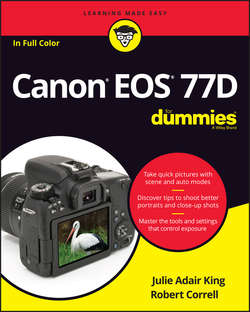Читать книгу Canon EOS 77D For Dummies - King Julie Adair - Страница 9
Part 1
Fast Track to Super Snaps
Chapter 1
Getting Up and Running
Customizing the Touch Screen
ОглавлениеYour camera’s touch screen works much like the ones found on smartphones and other touch-based devices. When the touch screen is enabled, as it is by default, you can simply touch the monitor to choose menu commands, change picture settings, scroll through your pictures, and more.
How you touch the screen depends on the task at hand. Here’s a rundown of the names assigned to various touch-screen moves, or gestures:
❯❯ Tap: Tap a finger on the monitor. (Figures and instructions throughout the book indicate exactly where to tap.)
❯❯ Drag: Using light pressure, drag your finger across the screen. On some menu screens, for example, you can drag up or down to scroll through a list of options.
❯❯ Swipe: Drag one or two fingers quickly across the screen. You use this gesture, known in some circles as a flick, to scroll through your pictures in Playback mode, just as you do when showing off your photos on a smartphone.
❯❯ Pinch in/pinch out: To pinch in, place your thumb at one edge of the screen and your pointer finger at the other. Then drag both toward the center of the screen. To pinch out, start in the center of the screen and swipe both fingers outward. Pinching is how you zoom in and out on pictures during playback.
You can customize two aspects of touch-screen behavior:
❯❯ Adjust (or disable) the touch-screen response: You can choose from three settings, accessed via the Touch Control option, found on Setup Menu 3 and shown in Figure 1-14. Standard is the default, setting the screen to respond to a “normal” amount of pressure. Don’t ask how the Powers That Be decided what that pressure level is – just know that if your normal pressure doesn’t evoke a response, you can change the setting from Standard to Sensitive. Choose Disable to make the touch screen totally inactive.
❯❯ Silence the touch screen: By default, the touch screen emits a tiny “boop” with every tap. If you find that annoying, choose the Beep option, found just beneath the Touch Control option on Setup Menu 3. The option that keeps the boop silent is Touch to Silence – silence indicated by a little speaker with a slash through it. The Disable setting turns off both touch-screen sounds and the beep the camera emits when focus is achieved.
FIGURE 1-14: Control the touch-screen response through this menu item.
CARING FOR THE CAMERA MONITOR
To keep the monitor in good working order, follow these precautions:
● Don’t use force when adjusting the monitor position. Although the monitor assembly is sturdy, treat it with respect as you adjust the screen position. The monitor twists only in certain directions, and it’s easy to forget which way it’s supposed to move. So, if you feel resistance, don’t force things – you could break the monitor. Instead, rely on that feeling of resistance to remind you to turn the screen the other way.
● Use only your finger to perform touch-screen functions. Use the fleshy part of your fingertip, not the nail or any other sharp object, and be sure that your fingers are dry because the screen may not respond if it gets wet.
● Don’t apply a screen protector. Canon also advises against putting a protective cover over the monitor, such as the kind people adhere to their smartphones. Doing so can reduce the monitor’s responsiveness to your touch.
● Watch the crunch factor. Before positioning the monitor back into the camera (whether face in or face out), use a lens brush or soft cloth to clean the back of the camera where the monitor folds in so there’s nothing on it that could damage the monitor.
● Clean smart. To clean the screen, use only the special cloths and cleaning solutions made for this purpose. (You can find them in any camera store.) Do not use paper products such as paper towels because they can contain wood fibers that can scratch the monitor. And never use a can of compressed air to blow dust off the camera – the air is cold and can crack the monitor.
